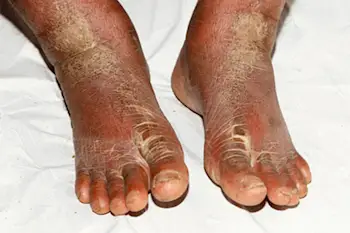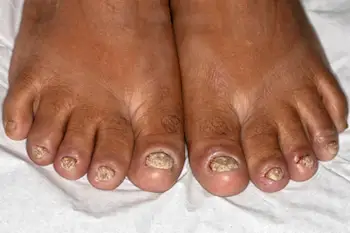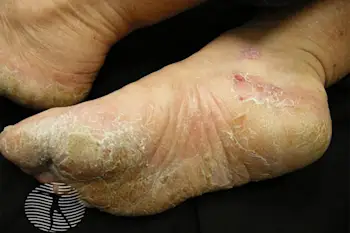From healthcentral.com
Psoriasis can be a challenge to manage when it’s on your feet. Experts share the treatments and lifestyle tweaks that can help
Managing your psoriasis often means taking things like setbacks and treatment plans step by step. But those metaphorical steps get a little trickier if the psoriasis is on your feet.
The chronic skin condition, which happens when the immune system goes into overdrive and triggers skin cells to grow abnormally, can occur on almost any part of the body, including the feet. Often, its signature symptoms include patches of skin inflamed, thick, dry, or scaly skin. Some people with psoriasis also experience small depressions in their toenails called pitting.
Here’s the catch: Research shows that psoriasis on the feet, also known as palmoplantar psoriasis, can be more disabling than psoriasis on other parts of the body because it can easily interfere as someone moves around and goes about normal day-to-day activities. But it doesn’t have to sit you down for good. Here, learn more about the symptoms to look for and get expert advice on how to treat and manage foot psoriasis.
Types of Psoriasis That Affect Your Feet
Plaque Psoriasis
Plaque psoriasis is the most common type of psoriasis on the feet (it’s also the most common type of psoriasis in general). It looks like thick, scaly, red or pink raised areas of skin (or plaques), often on the bottom of the feet. “These plaques can often cause itching, burning, and discomfort,” says Andrea Hui Austin, M.D., a board-certified dermatologist at Bay Area Cosmetic Dermatology in San Francisco. “The nails may also be affected, with thickening and pitting—which looks like tiny holes on the surface of the nail—or splitting of the nails.”
In people with darker skin, the plaques are rarely red or pink. Instead, they may be various shades of brown, purple, or gray, and may have silvery scales.
Guttate Psoriasis
When someone has guttate psoriasis, they typically break out in small, red, scaly patches often throughout the body (including the feet). The condition often comes on suddenly and people usually develop it after having strep throat or an upper respiratory infection.
Pustular Psoriasis
“Pustular psoriasis is characterized by tiny yellow fluid-filled blisters on the feet,” Dr. Austin says. “This can be extremely painful and can lead to dried scaling on the feet.” Youcan develop pustular psoriasis anywhere on your body, but it’s most common on the palms of your hands and the soles of your feet.
Psoriatic Arthritis
Some people with psoriasis have a form of arthritis called psoriatic arthritis, which involves symptoms like joint pain, swelling, and stiffness. The joint pain can occur anywhere throughout your body, including your toes, heels, tendons, and toenails.
“Psoriatic arthritis can appear concurrently with other forms of psoriasis that affect the feet,” Dr. Austin says.
Symptoms of Psoriasis on Your Feet
Foot psoriasis symptoms can vary from one person to the next and can also be different depending on which type of psoriasis you have. These symptoms are some of the most common, according to Cleveland Clinic:
Discoloured skin
Dry skin
Itching and burning skin
Thick, scaly, red plaques on the skin
Tiny depressions in the toenails called pitting
These are a few different factors that can cause psoriasis on the feet or trigger a flare-up:
Alcohol can trigger psoriasis and make psoriasis symptoms worse, research shows.
Exposure to environmental factors, like warm and moist environments can injure the skin and trigger a psoriasis flare, Austin explains.
Family history of psoriasis can make someone more likely to develop psoriasis, including on their feet.
Obesity can increase someone’s chances of developing diabetes and may also make psoriasis symptoms worse, research shows.
Smoking can increase your risk of developing psoriasis and may also worsen existing psoriasis, research shows.
Difference Between Foot Psoriasis and Athlete’s Foot
It can be challenging to tell the difference between psoriasis and athlete’s foot since both conditions cause a lot of the same symptoms. But to properly treat whatever is causing your symptoms—especially if you’ve never been diagnosed with either condition—you’ll want to see a dermatologist who can examine your skin.
Though it can be hard to tell apart athlete’s food and psoriasis, one helpful way to differentiate between the two is to pay attention to which area of the feet is affected. “Psoriasis usually involves the top and bottom of the feet,” says Shari Lipner, M.D., a board-certified dermatologist at Weill Cornell Medicine in New York City. “Athlete’s foot involves the bottom of the feet and in between the toes.” Here are a few more differences between foot psoriasis and athlete’s foot, per Dr. Lipner:
Cause: Foot psoriasis is a chronic autoimmune skin condition that results from an overactive immune system. Athlete’s foot is a contagious fungal infection caused by dermatophytes (fungi that thrives in warm, moist environments).
Appearance: Foot psoriasis typically appears as red, scaly patches or plaques on the feet. Athlete’s foot usually presents as red, peeling skin between the toes or on the soles of the feet. It may also cause blisters or infected open sores.
Itching: Foot psoriasis can be itchy, and the affected skin may crack, bleed, or become painful. Itching also happens with athlete’s foot, but it is also often accompanied by a burning sensation.
Common Symptoms: In addition to redness and scaling, individuals with foot psoriasis may experience nail changes on the toes, such as pitting, thickening, or discoloration. Athlete’s foot is primarily a fungal infection and does not affect the nails.
Most treatments for foot psoriasis aim to alleviate pain and discomfort and reduce symptom flare-ups. Usually this involves topical treatments and/or light therapy for the affected skin area, or systemic medications that treat psoriasis as a whole.
“Psoriasis of the feet can be challenging to treat due to constant pressure from weight, warm and moist environment in shoes, and daily activities such as walking,” Dr. Austin says. “With the help of a board-certified dermatologist, a successful treatment plan can be established to help a patient overcome their psoriasis.”
Let’s look at some common foot psoriasis treatments:
Topical Treatments
These treatments, applied directly to the affected skin, can help reduce inflammation, slow down skin cell growth, and alleviate itching, providing relief for people living with psoriasis. Common types of topical treatments for psoriasis on feet include:
Coal tar: Coal tar shampoos (you can use them on your body, too), foams, and ointments are an effective psoriasis treatment that help bring some people into long periods of remission.
Creams and ointments: Most cases of psoriasis are mild or moderate in severity and can be treated with creams and ointments. These can help bring symptoms like itching and swelling under control.
Salicylic acid: Salicylic acid has exfoliating properties and can help clear up flaking skin. “Emollients containing salicylic acid can help to soften and flatten the characteristic thick scales of psoriasis,” Dr. Austin says. “They can also help topical prescriptions such as corticosteroids penetrate the skin and provide healing effects.”
Topical corticosteroids: Available over-the-counter and by prescription, topical corticosteroids are a type of medication that’s available in various forms, including creams, ointments, and gels. They help reduce redness, itching, and inflammation.
Systemic Treatments
Systemic treatments are a type of prescription medication that work throughout the entire body. Some systemic medications commonly prescribed for psoriasis on the feet include:
Biologics: Biologics target the specific part of the immune system that causes psoriasis flares, Dr. Austin explains. They’re often used as a treatment for people with moderate or severe psoriasis when other treatments like topical creams and corticosteroids don’t help bring symptoms under control.
Oral corticosteroids: “For more severe cases, oral corticosteroids can be used to manage the immune system from within,” Dr. Austin says.
Phototherapy
Phototherapy, or light therapy, is a treatment used for various skin conditions, including psoriasis. Under the care of a dermatologist, this treatment emits UV light is emitted from a device that’s either full-body-sized or smaller and targeted to a specific area like your feet.
Lifestyle Tweaks
Changing up your lifestyle in some ways can sometimes help manage psoriasis and lower your chances of experiencing a psoriasis flare. You can approach this in a few ways, according to Cleveland Clinic:
Limiting alcohol: Alcohol can sometimes make psoriasis symptoms worse, research shows. By saying no to that wine or beer, you may be less likely to experience psoriasis symptoms brought on by alcohol use.
Not smoking: Research shows that smoking can increase your risk of developing psoriasis. It can also make your psoriasis more severe, and you may be less responsive to some treatments. If you quit smoking, some psoriasis symptoms may improve.
Proper foot care: Wearing breathable socks, washing your feet often, and regularly moisturizing may help prevent flare-ups.
Reducing stress: Studies have found that reducing stress can play an important role in managing psoriasis.
When psoriasis affects the feet, you may notice symptoms such as redness, thickening of the skin, dryness, and the presence of scaly patches. Additionally, nail abnormalities like small depressions can occur. While plaque psoriasis is the most prevalent type found on the feet, other variations exist. Managing foot psoriasis typically involves making lifestyle adjustments and using topical creams. In severe cases, oral medications may be necessary. If you aren’t sure if the itchy rash on your feet is psoriasis or not, your first step is to make an appointment with your doctor for confirmation.
https://www.healthcentral.com/condition/psoriasis/psoriasis-on-feet



No comments:
Post a Comment